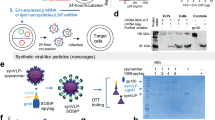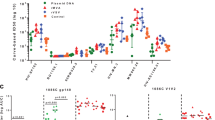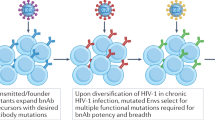Abstract
A highly desirable feature for an human immunodeficiency virus type 1 (HIV-1) vaccine is the ability to induce broadly reactive anti-envelope antibodies that can neutralize primary HIV-1 isolates. Two immunizations with an HIV-1 envelope-encoding plasmid together with recombinant granulocyte–macrophage colony-stimulating factor (rGM-CSF) resulted in high antibody titers in mice. The antibody induction was further enhanced after immunization with genes encoding HIV-1 envelopes originating from subtypes A, B and C. The sera from these animals were able to neutralize A, B and C viral isolates, whereas the sera from animals immunized solely with subtype B DNA neutralized only subtype B virus. The combined DNA vaccine gave serum antibodies with broad recognition of HIV-1 envelope epitopes as determined by peptide mapping. Cell-mediated immunity was not compromised by the increased humoral immunity. This demonstrates the ability of multiple envelope genes to induce the desired antibody response against several subtypes. Moreover, it documents the ability of rGM-CSF to enhance the potency of such a vaccine when given simultaneously. The strategy may be useful for making an HIV vaccine more potent and broadly effective against strains of different clades.
This is a preview of subscription content, access via your institution
Access options
Subscribe to this journal
Receive 12 print issues and online access
$259.00 per year
only $21.58 per issue
Buy this article
- Purchase on Springer Link
- Instant access to full article PDF
Prices may be subject to local taxes which are calculated during checkout





Similar content being viewed by others
References
UNAIDS/WHO. AIDS epidemic update: December 2003. UNAIDS/WHO, (www.unaids.org) 2003.
Wahren B . HIV in Europe – a growing threat. J Clin Virol 2001; 21: 171–173.
Kanki PJ et al. Human immunodeficiency virus type 1 subtypes differ in disease progression. J Infect Dis 1999; 179: 68–73.
McMichael AJ, Hanke T . HIV vaccines 1983–2003. Nat Med 2003; 9: 874–880.
Nabel GJ . HIV vaccine strategies. Vaccine 2002; 20: 1945–1947.
Berman PW VaxGen Announces Results of its Phase III HIV Vaccine Trial in Thailand: Vaccine Fails to Meet Endpoints, http://www.vaxgen.com/pressroom/index.html VaxGen Announces Results of its Phase III HIV Vaccine Trial in Thailand: Vaccine Fails to Meet Endpoints, http://www.vaxgen.com/pressroom/index.html〉 2003.
Hanke T, McMichael AJ . Design and construction of an experimental HIV-1 vaccine for a year – 2000 clinical trial in Kenya. Nat Med 2000; 6: 951–955.
Shiver JW et al. Replication-incompetent adenoviral vaccine vector elicits effective anti-immunodeficiency-virus immunity. Nature 2002; 415: 331–335.
Calarota SA et al. Immune responses in asymptomatic HIV-1-infected patients after HIV-DNA immunization followed by highly active antiretroviral treatment. J Immunol 1999; 163: 2330–2338.
Boyer JD et al. Therapeutic immunization of HIV-infected chimpanzees using HIV-1 plasmid antigens and interleukin-12 expressing plasmids. AIDS 2000; 14: 1515–1522.
Gaschen B . Diversity considerations in HIV-1 vaccine selection. Science 2003; 299: 1515–1518.
Moore JP, Parren PW, Burton DR . Genetic subtypes, humoral immunity, and human immunodeficiency virus type 1 vaccine development. J Virol 2001; 75: 5721–5729.
Muthumani K ZD et al. Novel engineered HIV-1 East African Clade-A gp160 plasmid construct induces strong humoral and cell-mediated immune responses in vivo. Virology 2003; 15: 134–146.
Barouch DH et al. Eventual AIDS vaccine failure in a rhesus monkey by viral escape from cytotoxic T lymphoctes. Nature 2002; 415: 335–339.
Barouch DH et al. Control of viremia and prevention of clinical AIDS in rhesus monkeys by cytokine-augmented DNA vaccination. Science 2000; 290: 486–492.
Barouch DH et al. Potent CD4+ T cell responses elicited by a bicistronic HIV-1 DNA vaccine expressing gp120 and GM-CSF. J Immunol 2002; 168: 562–568.
Sin JI et al. IL-12 gene as a DNA vaccine adjuvant in a herpes mouse model: IL-12 enhances Th1-type CD4+ T cell-mediated protective immunity against herpes simplex virus-2 challenge. J Immunol 1999; 162: 2912–2921.
Sin JI et al. Interleukin 7 can enhance antigen-specific cytotoxic-T-lymphocyte and/or Th2-type immune responses in vivo. Clin Diagn Lab Immunol 2000; 7: 751–758.
Kato H et al. Rectal and vaginal immunization with a macromolecular multicomponent peptide vaccine candidate for HIV-1 infection induces HIV-specific protective immune responses. Vaccine 2000; 18: 1151–1160.
Kim JJ et al. Cytokine molecular adjuvants modulate immune responses induced by DNA vaccine constructs for HIV-1 and SIV. J Interferon Cytokine Res 1999; 19: 77–84.
Moore AC, Kong WP, Chakrabarti BK, Nabel GJ . Effects of antigen and genetic adjuvants on immune responses to human immunodeficiency virus DNA vaccines in mice. J Virol 2002; 76: 243–250.
Zuber B et al. Induction of immune responses and break of tolerance by DNA against the HIV-1 coreceptor CCR5 but no protection from SIVsm challenge. Virology 2000; 278: 400–411.
Davis HL et al. CpG DNA is a potent enhancer of specific immunity in mice immunized with recombinant hepatitis B surface antigen. J Immunol 1998; 160: 870–876.
Zuber B, Mäkitalo B, Zuber AK, Wahren B . A novel potent strategy for induction of immunity to HIV-1 reverse transcriptase in primates. AIDS 2002; 16: 1839–1840.
Deml L et al. Immunostimulatory CpG motifs trigger a T helper-1 immune response to human immunodeficiency virus type-1 (HIV-1) gp 160 envelope proteins. Clin Chem Lab Med 1999; 37: 199–204.
Halperin SAVNG et al. A phase I study of the safety and immunogenicity of recombinant hepatitis B surface antigen co-administered with an immunostimulatory phosphorothioate oligonucleotide adjuvant. Vaccine 2003; 21: 2461–2467.
McCluskie MJ, Weeratna RD, Payette PJ, Davis HL . Parenteral and mucosal prime-boost immunization strategies in mice with hepatitis B surface antigen and CpG DNA. FEMS Immunol Med Microbiol 2002; 32: 179–185.
Gorny MK et al. Human monoclonal antibodies specific for conformation-sensitive epitopes of V3 neutralize human immunodeficiency virus type 1 primary isolates from various clades. J Virol 2002; 76: 9035–9045.
Ljungberg K et al. Enhanced immune responses after DNA vaccination with combined envelope genes from different HIV-1 subtypes. Virology 2002; 302: 44–57.
Chakrabarti BK et al. Modifications of the human immunodeficiency virus envelope glycoprotein enhance immunogenicity for genetic immunization. J Virol 2002; 76: 5357–5368.
Iwasaki A et al. Enhanced CTL responses mediated by plasmid DNA immunogens encoding costimulatory molecules and cytokines. J Immunol 1997; 158: 4591–4601.
Kusakabe K et al. The timing of GM-CSF expression plasmid administration influences the Th1/Th2 response induced by an HIV-1-specific DNA vaccine. J Immunol 2000; 164: 3102–3111.
Feltquate DM, Heaney S, Webster RG, Robinson HL . Different T helper cell types and antibody isotypes generated by saline and gene gun DNA immunization. J Immunol 1997; 158: 2278–2284.
Guay LA et al. Phase I/II trial of HIV-1 hyperimmune globulin for the prevention of HIV-1 vertical transmission in Uganda. AIDS 2002; 16: 1391–1400.
Poignard P, Saphire EO, Parren PW, Burton DR . gp120: Biologic aspects of structural features. Annu Rev Immunol 2001; 19: 253–274.
Wang B et al. Gene inoculation generates immune responses against human immunodeficiency virus type 1. Proc Natl Acad Sci USA 1993; 90: 4156–4160.
Klenerman P, Zinkernagel RM . Original antigenic sin impairs cytotoxic T lymphocyte responses to viruses bearing variant epitopes. Nature 1998; 394: 482–485.
Kundu SK et al. Role of preimmunization virus sequences in cellular immunity in HIV-infected patients during HIV type 1 MN recombinant gp160 immunization. AIDS Res Hum Retroviruses 1998; 14: 1669–1678.
Maurer T et al. CpG-DNA aided cross-presentation of soluble antigens by dendritic cells. Eur J Immunol 2002; 32: 2356–2364.
Liu HM et al. Immunostimulatory CpG oligodeoxynucleotides enhance the immune response to vaccine strategies involving granulocyte–macrophage colony-stimulating factor. Blood 1998; 92: 3730–3736.
Ayash-Rashkovsky M et al. Induction of antigen-specific Th1-biased immune responses by plasmid DNA in schistosoma-infected mice with a preexistent dominant Th2 immune profile. Biochem Biophys Res Commun 2001; 282: 1169–1176.
Weeratna RD, Brazolot Millan CL, McCluskie MJ, Davis HL . CpG ODN can re-direct the Th bias of established Th2 immune responses in adult and young mice. FEMS Immunol Med Microbiol 2001; 32: 65–71.
Wang R et al. Induction of antigen-specific cytotoxic T lymphocytes in humans by a malaria DNA vaccine. Science 1998; 282: 476–480.
Calarota S et al. Cellular cytotoxic response induced by DNA vaccination in HIV-1-infected patients. Lancet 1998; 351: 1320–1325.
MacGregor RR et al. First human trial of a DNA-based vaccine for treatment of human immunodeficiency virus type 1 infection: safety and host response. J Infect Dis 1998; 178: 92–100.
Kjerrström A et al. Interactions of single and combined human immunodeficiency virus type 1 (HIV-1) DNA vaccines. Virology 2001; 284: 46–61.
Akerblom L et al. Neutralizing cross-reactive and non-neutralizing monoclonal antibodies to HIV-1 gp120. AIDS 1990; 4: 953–960.
Broliden PA et al. Identification of human neutralization-inducing regions of the human immunodeficiency virus type 1 envelope glycoproteins. Proc Natl Acad Sci USA 1992; 89: 461–465.
Calarota S et al. Immunodominant glycoprotein 41 epitope identified by seroreactivity in HIV type 1-infected individuals. AIDS Res Hum Retroviruses 1996; 12: 705–713.
Wang JJ, Steel S, Wisniewolski R, Wang CY . Detection of antibodies to human T-lymphotropic virus type III by using a synthetic peptide of 21 amino acid residues corresponding to a highly antigenic segment of gp41 envelope protein. Proc Natl Acad Sci USA 1986; 83: 6159–6163.
Hinkula J et al. Immunological and virological interactions in patients receiving passive immunotherapy with HIV-1 neutralizing monoclonal antibodies. J Acquir Immune Defic Syndr 1994; 7: 940–951.
Devito C, Levi M, Broliden K, Hinkula J . Mapping of B-cell epitopes in rabbits immunised with various gag antigens for the production of HIV-1 gag capture ELISA reagents. J Immunol Methods 2000; 238: 69–80.
Acknowledgements
We thank Reinhold Benthin and Gunnel Engström for outstanding technical assistance and Roya Hakimnia, Sayi Kimwaga-Stika, Sandra Melki and Marwa Osman for the gp41 ELISA. This work was supported by the Foundation for Strategic Research: the Infection and Vaccinology programme and the Inflammation programme; and by the Swedish Research Council and EU Grant ICA4-CT-2002-10036.
Author information
Authors and Affiliations
Rights and permissions
About this article
Cite this article
Rollman, E., Hinkula, J., Arteaga, J. et al. Multi-subtype gp160 DNA immunization induces broadly neutralizing anti-HIV antibodies. Gene Ther 11, 1146–1154 (2004). https://doi.org/10.1038/sj.gt.3302275
Received:
Accepted:
Published:
Issue Date:
DOI: https://doi.org/10.1038/sj.gt.3302275
Keywords
This article is cited by
-
A New Multi-clade DNA Prime/Recombinant MVA Boost Vaccine Induces Broad and High Levels of HIV-1-specific CD8+ T-cell and Humoral Responses in Mice
Molecular Therapy (2007)
-
Therapeutic immunization for HIV
Springer Seminars in Immunopathology (2006)
-
Building collaborative networks for HIV/AIDS vaccine development: the AVIP experience
Springer Seminars in Immunopathology (2006)



